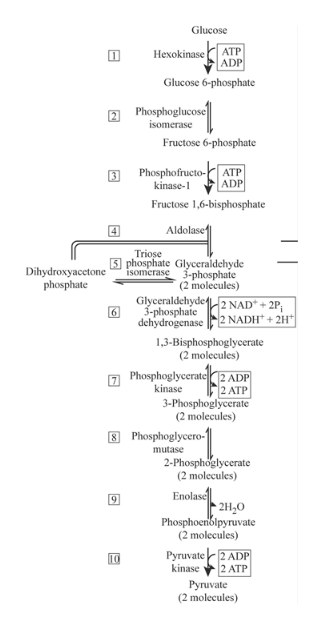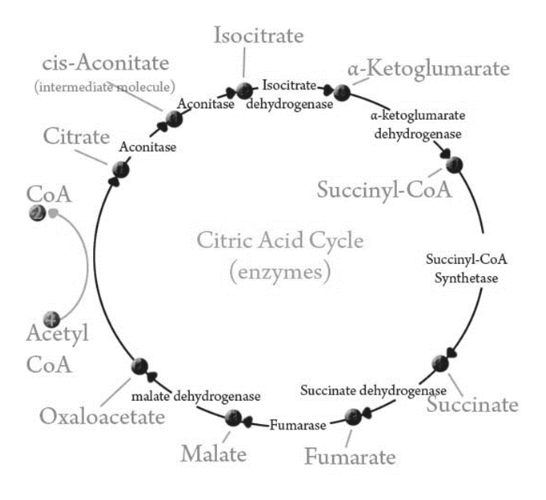Could I have an explanation of the glycolysis, citric acid cycle, and the electron transport chain, and the breakdown of each to help understand? Thanks!
Electron Transport Chain
The electron transport chain, also known as the electron transport system, is a group of proteins that transfer electrons through a membrane within mitochondria to create a gradient of protons that drives adenosine triphosphate (ATP)synthesis. The cell uses ATP as an energy source for metabolic processes and cellular functions. ETC involves series of reactions that convert redox energy from NADH (nicotinamide adenine dinucleotide (NAD) + hydrogen (H)) and FADH2(flavin adenine dinucleotide (FAD)) oxidation into proton-motive force(PMF), which is then used to synthesize ATP through conformational changes in the ATP synthase complex, a process known as oxidative phosphorylation.
Metabolism
Picture a campfire. It keeps the body warm on a cold night and provides light. To ensure that the fire keeps burning, fuel needs to be added(pieces of wood in this case). When a small piece is added, the fire burns bright for a bit and then dies down unless more wood is added. But, if too many pieces are placed at a time, the fire escalates and burns for a longer time, without actually burning away all the pieces that have been added. Many of them, especially the larger chunks or damp pieces, remain unburnt.
Cellular Respiration
Cellular respiration is the cellular process involved in the generation of adenosine triphosphate (ATP) molecules from the organic nutritional source obtained from the diet. It is a universal process observed in all types of life forms. The glucose (chemical formula C6H12O6) molecules are the preferred raw material for cell respiration as it possesses a simple structure and is highly efficient in nature.
Could I have an explanation of the glycolysis, citric acid cycle, and the electron transport chain, and the breakdown of each to help understand?
Thanks!
In the glycolysis, pathway molecules of glucose and fructose are degraded and produce pyruvate. Pyruvate dehydrogenase complex further convert the pyruvate to acetyl-CoA that enters to the Citric acid cycle. Citric acid cycle involves the oxidation of acetyl-CoA and results in production of CO2 and water and reduces the NADH to NADPH. NADH and succinate from the citric acid cycle oxidized and undergo the electron transport chain in the mitochondria and generate ATP. The production of acetyl-CoA, ATP, and NADPH from glucose takes place by the pathways: glycolysis, citric acid cycle, and electron transport chain.
In glycolysis reaction 10steps are involved to convert glucose to pyruvate and those are as follows:
- In Reaction 1 of glycolysis, a phosphoryl group is transferred from ATP to glucose to form glucose-6-phosphate (G6P) in a catalytic reaction continues by hexokinase. In this reaction kinase is act as an enzyme that transfers the phosphoryl groups between ATP and a metabolite. Metabolite serves the phosphoryl group acceptor.
- Reaction 2 of glycolysis explains the conversion of glucose-6-phosphate (G6P) and fructose-6-phosphate (F6P) in presence of phosphor-glucose isomerase (PGI). This reaction represents the isomerization of an aldose to a ketone.
- In Reaction 3 of glycolysis, phosphofructokinase (PFK) phosphorylates fructose-6-phosphate (F6P) to form fructose-1,6-biphosphate (FBP).
- Reaction 4 of glycolysis pathway, aldolase catalyzes the cleavage of fructose-1, 6-biphosphate to form the two trioses glyceraldehyde-3-phosphate (GAP) and dihydroxyacetone phosphate. This represents the carbon-carbon cleavage occurs in retro aldol condensation. The cleavage is occurs in between C3 and C4 of fructose-1, 6-biphosphate.
- Reaction 5 represents the products of the of the aldol cleavage reaction, in which glyceraldehyde-3-phosphate converted to dihydroxyacetone phosphate. In this reaction interconversion occurs by an isomerization reaction with an enediol intermediate. Triose phosphate isomerase catalyzes this process in this reaction of glycolysis.
- Reaction 6 of glycolysis represents the oxidation and phosphorylation of glyceraldehyde-3-phosphate (GAP) in presence of NAD+ and Pi as catalyzed by glyceraldehyde-3-phosphate dehydrogenase to form 1, 3-Bisphosphoglycerate.
- Reaction 7 of glycolysis pathway yields ATP with 3-phosphoglycerate (3GP) in a reaction that is catalyzed by enzyme phosphoglycerate kinase (PGK). In this reaction reverse phosphorylation occurs in presence of kinase enzyme. From 1, 3-Bisphosphoglycerate one phosphate group is transferred to 3-phosphoglycerate (3GP) and ATP.
- Reaction 8 of glycolysis represents the conversion of 3-phosphoglycerate (3PG) to 2-phosphoglycerate in presence of phosphoglycerate mutase. This reaction also represents the isomerization reaction.
- Reaction 9 of glycolysis explains the dehydration reaction in which 2-phosphoglycerate is dehydrated to phosphoenolpyruvate (PEP) in a reaction that is catalyzed by enolase.
- In the final reaction, Reaction 10 of glycolysis pyruvate kinase enhances the phosphoenolpyruvate in presence of ADP form pyruvate and ATP. The pyruvate kinase reaction is highly exergonic that gives more energy to drive ATP synthesis, a substrate-level phosphorylation reaction.

Citric acid cycle:
Citric acid cycle starts, pyruvates give acetyl-CoA which enters the citric acid cycle. Enzymes used in TCA are citrate synthase, aconitase, isocitrate dehydrogenase, α- ketoglutarate dehydrogenase, succinyl CoA synthetase, succinate dehydrogenase, fumarase, and malate dehydrogenase.
- Step 1 of citric acid cycle is the formation of citrate from acetyl coA, this process is Claisen condensation process because methyl group found on acetyl coA gets converted into methylene of citrate. Acetyl CoA reacts with oxaloacetate to produce citrate with the help of citrate synthase. The conversion of citrate to isocitrate is isomerization reaction. Presence of cofactors in the reactions is mandatory for the functioning of enzymes. Enzymes can catalyze the reaction only in the presence of cofactors.
- Step 2 is the process of conversion of citrate into isocitrate with the formation of one intermediate cis- aconitate. In this process first dehydration and then rehydration takes place. Citrate undergoes dehydration and cis aconitate is obtained, then rehydration of cis aconitate takes place which produces isocitrate. Enzyme aconitase is responsible for conversion of citrate into isocitrate. When isocitrate converts into α- ketoglutarate then isocitrate dehydrogenase enzyme gets involve. The cofactor which is required at this step is NADH.
- Step 3 is the production of α-ketoglutarate from isocitrate through oxidative decarboxylation, and a hydroxyl group of isocitrate is oxidized into carbonyl. The enzyme Isocitrate dehydrogenase converts isocitrate into α- ketoglutarate. . In the next step when α- ketoglutarate gets convert into succinyl CoA α- ketoglutarate dehydrogenase complex enzyme takes part and NADH is found present to facilitate the enzyme functioning.
- Step 4 is the production the reaction of conversion of α- ketoglutarate into succinyl coA which is a oxidative decarboxylation The enzyme α-ketoglutarate dehydrogenase complex converts the α-ketoglutarate into succinyl- CoA.
- Step 5 is the conversion of succinyl coA into succinate via substrate level phosphorylation GTP is the required cofactor when succinyl CoA synthetase catalyzes the conversion of succinyl CoA into succinate. Succinyl co A is converted into succinate, the succinyl CoA synthetase catalyses the reaction. Succinate is an intermediate and quickly gets converted into fumarate with the action of succinate dehydrogenase.
- In Step 6, the succinate is converted into fumarate via oxidation Fumarate is converted into L-Malate by hydration reaction. Finally by oxidation reaction L-Malate is converted into oxaloacetate. Fumarase enzyme uses FADH2 as its cofactor when fumarate is converted into malate. Malate dehydrogenase catalyzes malate to get it convert into oxaloacetate.
- In step 7, the dehydrogenation of malate occurs to get convert it into oxaloacetate. NADH is present for the functioning of malate dehydrogenase when malate gets convert into oxaloacetate. Malate dehydrogenase catalyzes malate to get it convert into oxaloacetate.

Step by step
Solved in 5 steps with 2 images









